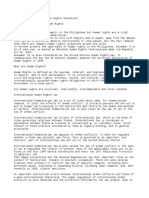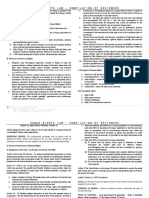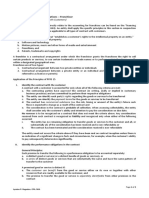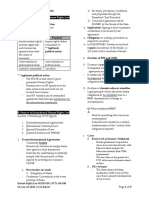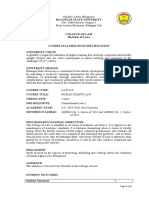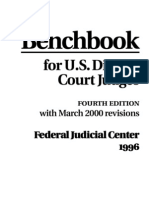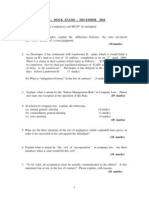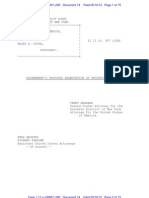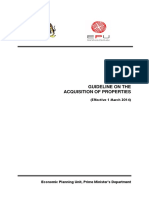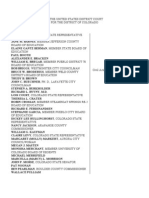Human Rights Law Reviewer PDF
Human Rights Law Reviewer PDF
Uploaded by
Ricky Quizzagan MaguigadCopyright:
Available Formats
Human Rights Law Reviewer PDF
Human Rights Law Reviewer PDF
Uploaded by
Ricky Quizzagan MaguigadOriginal Title
Copyright
Available Formats
Share this document
Did you find this document useful?
Is this content inappropriate?
Copyright:
Available Formats
Human Rights Law Reviewer PDF
Human Rights Law Reviewer PDF
Uploaded by
Ricky Quizzagan MaguigadCopyright:
Available Formats
HUMAN RIGHTS REVIEWER § Right to privacy, freedom of
opinion and expression
CHAPTER 1: THE NATURE OF HUMAN § Second generation of economic, social, and
RIGHTS cultural rights (ESC)
o Started to be recognized when people
Human Rights – realized that the first generation of rights
§ The aggregate of privileges, claim, benefits, would be valueless without the enjoyment of
entitlements and moral guarantees that pertain to man economic, social, and cultural rights
because of his humanity. o The experience of third world countries in
§ The legal and moral entitlements that have evolved as their struggle against Colonialism, the
a basis for constructing how state power is used and influence of Socialism, and the encyclicals
particularly to limit its use against he rights of citizens. of Popes all contributed to the development
§ As human beings, we have worth and dignity. of the second generation of rights (these
are the factors that helped in creating the
Other descriptions of Human Rights – second generation of rights)
§ Jose Zalaquett – “Human Rights is regarded as a o This is also called as “the second
system of values or as elements which are inherent to generation of equality rights”
human dignity.” o Some examples are:
§ Jacques Maritain (in his book, The Rights of Man) – § Right to work
“The human person possesses rights because of the § Right to social security
very fact that it is a person, a whole, master of itself, § Right to form and join trade
and of its acts, and which consequently is not merely unions
a reason to an end, but an end which must be treated § Right to education
as such.” § Right to health
o We can’t be “means” because we have § Right to shelter
freewill. Human beings are the “end”. § Third generation of solidarity rights (or collective
rd
§ Pope John 23 (in his papal encyclical, Pacem In rights)
Terris) – “Any human society must lay down as a o The third generation is intended to benefit
foundation, this principle, that every human being is a individuals, groups, and peoples and its
person, his nature is endowed with intelligence and realization will need global cooperation
full will. By virtue of this, he has rights and duties, based on international solidarity
flowing directly and simultaneously from his very o This is to acknowledge everyone in the
nature.” world
§ Jose W. Diokno – “No cause is more worthy that the o This is also called as “the third generation of
cause of human rights. They are what make man solidarity rights”
human.” o Some examples are:
§ Right to peace
Kinds of Human Rights – French lawyer Karel Vasak § Right to development
classified them into three (3) generations of rights (however, § Environmental rights
there are currently four (4) generations of rights already). § Right of self-determination
§ First generation of civil and political rights § Right to food
o Gradually evolved over centuries as it § Rights of women and children
served as the protection of individuals from § Fourth generation of rights
the arbitrary exercise of police power o This right is due to disasters and the
o This can be found in Article III of the 1987 experience of Africans
Constitution o This right is still emerging
o The first right known to men o Some examples are:
o It is also known as the “first generation of § Right to disasters
liberty rights” § Right to human assistance
o Winluck Wahiu stated that the first § Right to water
generation of rights are individual rights
against the state Principles of Human Rights – Made to point out that the
o Some examples are: international community must treat human rights in equal
§ Right against torture manner, on the same footing, and with the same emphasis.
§ Right to equal protection against Jose W. Diokno made emphasis that the validity of these
any discrimination principles that people cannot enjoy civil and political rights
§ Right against arbitrary arrest and unless we enjoy economic, cultural, and social rights, anymore
detention than we can insure our civil and political rights.
§ Right to a fair and public hearing (1) Universality
by an independent and impartial
tribunal
© Lara Murallos reviewer J please do not hesitate to correct anything. 1
o Rights that belong to and are to be enjoyed CHAPTER 2: SOURCES AND
by all human beings without any distinction
of any kind FOUNDATIONS OF HUMAN RIGHTS LAW
o It means that it is internationally-recognized
and that its basic core minimum must be The 1987 Constitution – The Constitution itself is a source, and
observed everywhere not only the Bill of Rights
(2) Indivisibility – All the generations cannot be The 1987 Constitution is the basic source of human
separated from one another rights law in the Philippines
(3) Interdependence – There is co-equal in importance, As early as Biak na Bato, our forefathers are
and that these rights are guaranteed that an individual conscious about the rights of human beings
can live decently and in dignity A novel feature of the 1987 Constitution is the
independent constitutional office of the Commission of
Characteristics of Human Rights – Human Rights, the first national human rights
(1) Inherent commission in the world
o Rights are the birthright of all human beings The CHR is not a regular commission, not like the
o Not obtained and granted though any CoA or the civil service, etc. It is an independent
human action or intervention commission which investigates on human rights
(2) Inalienable violations and establishes programs of education and
o No person can deprive any person these information to enhance respect for the primacy of
rights human rights
o No person can repudiate these rights by This Constitution is sometimes called as “Human
himself Rights Constitution”
o Rights that cannot be subjected to the The 1987 Constitution is the seventh Constitution
commerce of man drafted by Filipinos
(3) Universal – Rights belong to every human being no
matter what he or she is like International Bill of Rights – U Thant, former Secretary
General of the UN called the three (3) documents and the
Stages of Human Rights – Optional Protocol to the Covenant on Civil and Political Rights
(1) Idealization – Notions about human rights start in the as “Magna Carta for mankind” and is “the essential prerequisite
realm of ideas that reflect a consciousness against for peace at home and in the world”
oppression or inadequate performance of the State Universal Declaration of Human Rights (UDHR)
(2) Positivization – Where the support for the ideas o The Commission on Human Rights of the
become strong, and thus incorporate them into legal United Nations drafted the UDHR, while the
instruments United Nations passed it
(3) Realization – When these rights are already being o The chairwoman was former first lady
enjoyed by the citizens by the transformation of the Eleanor Roosevelt
social, economic, and political order o The declaration was adopted by 48 votes in
favor, none against and eight abstentations
Three obligations of State Parties o Carlos Romulo was also there during the
(1) Obligation to respect drafting of the CHR of the UN
o Article 2(1) of the ICCPR contain this o The Preamble to the UDHR refers to the
obligation concepts of inherent human dignity and one
o Indicates that the negative character of civil inalienable nature of human rights. It also
and political rights, commanding the State called for inter-cultural consensus by
to refrain from restricting the exercise of indicating that a common understanding of
these rights is not expressly allowed the rights and freedoms is to achieve
(2) Obligation to ensure promotion of universal respect for and
o Article 2(1) of the ICCPR also encompasses observance of human rights and
this obligation, that State parties must be fundamental freedoms
proactive to enable individuals to enjoy their o The UDHR is the first internationally
rights adopted catalogue of human rights
o Article 2(2) of the ICCPR points out that to o Mary Robinson, former High
provide for an effective remedy to victims of Commissioner for Human Rights, said that
human rights, it must adopt executive, the common language of humanity, the
judicial and legislative measures language of human rights, is enshrined in
(3) Obligation to protect – to prevent private individuals, the UDHR
groups, or entities from interfering with the individual’s International Covenant on Civil and Political
civil and political rights Rights (ICCPR)
o Adopted unanimously by 106 States and
entered into force in 1976
© Lara Murallos reviewer J please do not hesitate to correct anything. 2
International Covenant on Economic, Social and o 1935 Constitution, 1973 Constitution, 1986
Cultural Rights Freedom Constitution – Bill of Rights
o 1943 Constitution – Duties and Rights of the
Philosophy – Western thinkers inspired the formulation of the Citizens
UDHR, the English Bill of Rights, the American Declaration of o 1899 Malolos Constitution – The Filipinos
Independence, the French Declaration of the Rights of Man and and their National and Individual Rights
of the Citizens, and other human rights instruments Bill of Rights – an enumeration of civil and political rights that
John Locke are self-executing. It also serves as a restriction upon the
o English philosopher who wrote “The Second powers of the State in order to preserve constitutional harmony
Treatise of Government” where he argued and stability.
that sovereignty resides in the people Father Joaquin Bernas, SJ – The Bill of Rights is to
o Contract between the governed and the declare some forbidden zones in the private sphere
government inaccessible to any power holder.
o Government has the duty to promote
impartial good The provisions in the Bill of Rights can be classified into
o He wrote that legitimate government is duty- four (4) types
bound to preserve the rights of life, liberty, (1) The completely new provisions
health, and property of its citizens; to o Section 12(4), 18(1), 19(2)
prosecute and punish those who violate the (2) The old provisions that contain amendments by
rights of others and to pursue the public addition
good o Section 4, 6, 7, 11, 12(1), 12(2), 12(3), 13,
o The social contract theory is what 19(1)
permeates many national constitutions (3) The old provisions where words and phrases
Jean Jacques Rosseau were amended by deletion
o Inspired by John Locke that’s why their o Section 2, 15
POV seems the same (4) The old provisions that remained intact
o Franco-Swiss philosopher who wrote “The o Section 1, 3(1), 5, 9, 10, 20, 21, 22
Social Contract”
o He argued that the citizens surrender their Comprehensive Agreement on Respect for Human Rights
rights to the general will which must aim at and International Humanitarian Law – this is the fruit of the
the impartial good negotiations of the government and the rebels
o This also abandoned claims of natural right, The first substantive agreement signed by the
that citizens must preserve themselves and Negotiating Panels of the Government of the
remain free Philippines in the Hague, Netherlands
Baron de Montesquieu This comprehensive agreement consists of seven (7)
o French philosopher who wrote “The Spirit of parts:
the Laws”, which explained how he saw o The Preamble – introduces the Agreement
despotism as a standing danger for any and articulates the reasons for and the
government intention of the parties
o This theory of separation of powers initially o Declaration of Principles
inspired the US Constitutional Convention. o Bases, Scope, and Applicability
Through this, check and balance and o Respect for Human Rights
separation of powers became a reality o Respect for International Humanitarian Law
o James Madison was inspired by de o Joint Monitoring Committee
Montesquieu’s work that he wrote Federalist o Final provisions
51, which he submitted to Thomas
Jefferson CHAPTER 4: ECONOMIC, SOCIAL, AND
Religion – embedded in sacred scriptures are lessons and
CULTURAL RIGHTS
teachings on human dignity, sanctity of life, worth of conscience,
social justice, respect for integrity of creation, and other rights. Social Justice and Human Rights in the 1987 Constitution
It is an innovation in the 1987 Constitution
Social Justice is not defined in the 1987 Constitution
CHAPTER 3: CIVIL AND POLITICAL o Teresa Nieva, Chairwoman of the
RIGHTS Committee on Social Justice, defined it as
the centerpiece of the 1987 Constitution and
Bill of Rights in the 1987 Constitution – that rights, dignity, and participation remain
The Bill of Rights is a regular fixture in all Philippine illusory without it.
Constitutions, except in the Biak na Bato Constitution o Jose P. Laurel defined Social Justice in
of 1897 Calalang vs. Williams saying that it is
neither communism nor despotism, not
© Lara Murallos reviewer J please do not hesitate to correct anything. 3
atomism, nor anarchy, but the humanization right to freedom, equality, and adequate
of laws and the equalization of social and conditions of life, in an environment of a
economic forces by the State so that justice quality that permits a life of dignity and well
in its rational and objectively secular being, and he bears a solemn responsibility
conception may at least be approximated. to protect and improve the environment for
present and future generations.
Universal Declaration of Human Rights
A repository of the first generation and second Women, Children, Persons with Disabilities, Indigenous
generation of rights Peoples
o Articles 22 to 27 of the 1987 Constitution They are usually the world’s vulnerable,
enumerates these rights disadvantaged, and marginalized groups.
The second generation of rights served as an Women are always denied of their basic human
inspiration for regional human rights and national rights, which roots from restring their choices,
constitutions. increasing their vulnerability to violence, and making it
difficult for them to obtain justice.
International Covenant on Economic, Social, and Cultural Children are exploited, abused, maltreated, deprived
Rights of education, sold, subjected to cruel methods of
This is the sister covenant of the International punishment, and discriminated against.
Covenant on Civil and Political Rights Persons with disabilities have long-term physical,
mental, intellectual, or sensory impairments, which in
CHAPTER 5: SOLIDARITY OR COLLECTIVE interaction with various barriers may hinder them full
and effective participation in society on an equal basis
RIGHTS with others.
o RA 7277 defines PWD as those suffering
Peace, Development, Environment from restriction or different abilities, as a
Right to peace belongs to the category of Solidary result of a mental, physical, or sensory
Rights. impairment, to perform an activity in the
o Locally, this could be witnessed in the manner or within the range considered
Bangsamoro Peace Agreement and the normal for a human being.
Bangsamoro Basic Law, which is currently Indigenous people are those that have historically
being implemented belonged to a particular region or country before its
o Internationally it could be witnessed in colonization or transformation into a nation, state, and
places like Syria, Israel, and Latin America, may have different—often-unique—cultural, linguistic,
wherein although it is still not yet visible, the traditional, and other characteristics to those of the
efforts of trying to establish peace is dominant culture of that region or state.
eminent
The right to development is another example of a
CHAPTER 6: REMEDIES AND
solidary right.
o Development is a comprehensive PROCEDURES FOR RESPONDING TO
economic, social, cultural, and political HUMAN RIGHTS VIOLATIONS AND HUMAN
process, which aims at the constant
improvement of the well being of the entire
RIGHTS ABUSES
population and of all individuals through
their meaningful participation. Human Rights Violations
o Amartya Sen defines it as a process of These are acts committed by or at the instigation of or
expanding the freedom that people enjoy with the consent of a public official or other persons
and requires the removal of major sources acting in an official capacity contrary to human rights
of unfreedom like poverty, tyranny, poor law, causing bodily, mental, pain, suffering, or death.
economic opportunities, systematic social When non-State actors commit these transgressions,
derivation, neglect of public facilities, their actions are called crimes or human rights
intolerance or overactivity of repressive abuses.
states.
o Poverty embraces the spectrum of Domestic remedies
conditions where freedoms are diminished May take in form of:
and denied. o Civil remedies
Right to environment is also important due to global o Criminal remedies
warming, climate change, the damaging effects of o Administrative remedies
climate change on human beings, and the May opt to file a complaint with the Commission on
degradation of the world’s environment. Human Rights
o It is pointed out in 1972 at the Stockholm o Task is solely fact-finding investigation
Conference that man has the fundamental
© Lara Murallos reviewer J please do not hesitate to correct anything. 4
o Prosecution must be handled by the reliable sources about violations of human
Department of Justice until case is resolved rights wherever they occur in the world.
by the court
CHAPTER 7: PREVENTIVE MECHANISMS
International remedies
Based on treaties and non-treaty procedures IN THE FIELD OF HUMAN RIGHTS
The reporting requirement The office of the UN High Commissioner for Human Rights
Periodically submit reports to the Secretary General of Agency that works to promote and prevent human
the United Nations or to the monitoring body created rights violations
by the treaty. Guaranteed under international law
Comprehensive accounts of the measures adopted by Stipulated in the UDHR
the State Parties to apply the provisions of the UN Established by the UN General Assembly on 20
Conventions. December 1993
Ordinate human rights
International Criminal Court Engage in human rights activities and incorporate
The Rome Statute established the International them in governmental programs
Criminal Court It has the following proactive and preventive
Considered as the most ambitious international legal responsibilities:
initiative in the history of modern law o Promoting and protecting the effective
Has the power to investigate, prosecute, and convict enjoyment
individuals o Carrying out the tasks assigned by
Exercises international jurisdiction over criminals competent bodies of the UN
3 ways which an investigation by the ICC may be o Promoting and protecting the realization of
initiated the right to development
1. A State party may refer a “situation” to the o Providing advisory services and technical
prosecutor, where it appears that one or and financial assistance
more crimes within the jurisdiction of the o Coordinating relevant UN education and
Court was committed public information in the field of human
2. The Security Council may refer a “situation” rights
to the prosecutor o Playing an active role in removing current
3. The Prosecutor may initiate investigation obstacles and in meeting the challenges to
motu proprio or on her own, on the basis of the full realization
information received from any reliable o Engaging in a dialogue with governments in
source the implementation of his/her mandate
o Enhancing international cooperation for the
The Public 1235 Procedure promotion and protection of human rights
Economic and Social Council resolution 1235 o Coordination of the human rights promotion
authorizes the Commission on Human Rights and the and protection activities throughout the
Sub-Commission on Prevention of Discrimination and United Nations system
Protection of Minorities. o Naturalization, adaptation, strengthening
Information may be furnished by the States and streamlining of the UN machinery in the
field of human rights to improve its
The Confidential 1503 Procedure efficiency and effectiveness
Adopted by ECOSOC o Overall supervision of the Office of the High
For more confidential complaints procedure in order to Commissioner
deal with communications indicating a consistent
pattern of gross and reliably attested violations of National Human Rights Institutions
human rights and fundamental freedoms An organization that has been established by national
governments with the specific role of protecting and
Special Country Rapporteurs and Thematic Rapporteurs promoting human rights.
The CHR has developed two types of instruments to Paris Principles – provides for standards and
supervise implementation of human rights around the adequate funding
world pursuant to ECOSOC resolution 1235. o Independence
o Special Country Rapporteurs – It has o Broad human rights mandate
appointed specific country rapporteurs and o Adequate funding
working groups mandated to report annually o Inclusive and transparent selection and
to CHR. appointment process
o Thematic Rapporteurs or working groups – 1987 Constitution
working groups already formed, which o Proactive and preventive role in the
examine relevant information from all promotion of respect for human rights
© Lara Murallos reviewer J please do not hesitate to correct anything. 5
o Conduct research
o Promote awareness
o Encourage the involvement of non-
governmental organizations
Non-governmental organizations (NGOs)
Chief Justice Artemio V. Panganiban classifies
NGOs as belonging to civil society, and reiterated that
it has been the forefront of the fight for liberty and
considered a pillar of democracy, the conscience of
government and the overseer of governmental
actions.
Rachel Brett stated that it is developing a human
rights culture by making people aware of their rights,
of their responsibility not to violate the rights of others,
and of the possibilities of redress including supporting
individuals in bringing cases, whether with the national
system, or under regional or international procedures
CHAPTER 8: THE JUDICIARY, THE
ACADEME, AND THE FAMILY ON
BUILDING A HUMAN RIGHTS CULTURE
Human Rights Culture
A shared communitarian belief in the inherent dignity
and of the equal and inalienable rights of the
members of the human family.
A shared consensus that the dignity and worth of
every human person can be upheld and honored if the
State and non-State actors undertake efforts and
initiatives to uphold and honor human rights.
Jose Ayala Lasso – first United Nations High
Commissioner for Human Rights stated that Human
Rights is one of the most important contributions that
can be made to future generations.
The Judiciary
A key player in the development of human rights
culture
Social action litigation to protect the marginalized
Judicial activism – revolution by law through decisions
and rules
The Academe
Schools are compelled to tech human rights, love for
country, respect, and other virtues to children.
The Family
The only constitution that has a provision about the
Family is the 1987 Philippine Constitution
“Values are caught not taught”
George Benson said that great ideas and fine
principles do not live from generation to generation
just because they are good, nor because they have
been carefully legislated. Ideals and principles
continue from generation to generation only when they
are built into the hearts of children as they grow up.
© Lara Murallos reviewer J please do not hesitate to correct anything. 6
You might also like
- Human Rights EducationDocument23 pagesHuman Rights Educationcriminologyalliance75% (20)
- Zambia Employ Permit Appln Form 23Document4 pagesZambia Employ Permit Appln Form 23anildel100% (3)
- HUMAN RIGHTS LAW Rene SarmientoDocument124 pagesHUMAN RIGHTS LAW Rene SarmientoPrince Jethro Santua Santua100% (7)
- Human Rights Law Jorge CoquiaDocument51 pagesHuman Rights Law Jorge CoquiaHEMERHYNI BARAGUIR100% (1)
- Human Rights Law Reviewer Commissioner SarmientoDocument5 pagesHuman Rights Law Reviewer Commissioner SarmientoMegan Mateo82% (11)
- Human Rights Law ReviewerDocument46 pagesHuman Rights Law ReviewerElixirLanganlangan100% (4)
- Legal Medicine ReviewerDocument88 pagesLegal Medicine ReviewerRoxanne Solidarios80% (10)
- Introduction To Human RightsDocument14 pagesIntroduction To Human RightsAustine Clarese Velasco100% (1)
- Accounting For Franchise (PFRS 15) HandoutsDocument3 pagesAccounting For Franchise (PFRS 15) HandoutsTeofel John Alvizo Pantaleon75% (4)
- Human Rights LawDocument5 pagesHuman Rights LawMark M. MabalayNo ratings yet
- CRLJ 121 Prelim Module 1Document5 pagesCRLJ 121 Prelim Module 1Sarah DiazNo ratings yet
- HUMAN RIGHTS LAW Q&A (JORGE COQUIA Book)Document28 pagesHUMAN RIGHTS LAW Q&A (JORGE COQUIA Book)flippchick100% (16)
- Human Rights Course Outline.Document3 pagesHuman Rights Course Outline.Sai Rosales60% (5)
- PETRALBA - Human Rights Law (2013)Document175 pagesPETRALBA - Human Rights Law (2013)Pre Pacionela100% (5)
- Course Syllabus Human Rights LawDocument13 pagesCourse Syllabus Human Rights LawGuiller C. Magsumbol100% (3)
- Human Rights Law Syllabus GRMDocument6 pagesHuman Rights Law Syllabus GRMRalph JaramilloNo ratings yet
- Court Testimony Module 1 1Document15 pagesCourt Testimony Module 1 1Alexandro Keya100% (1)
- Organizational Chart PDFDocument1 pageOrganizational Chart PDFRicky Quizzagan Maguigad0% (1)
- Outreach Project ProposalDocument4 pagesOutreach Project ProposalRicky Quizzagan Maguigad100% (1)
- Human RightsDocument111 pagesHuman RightsAbhikaam100% (1)
- Human Rights Midterms Reviewer Under Atty. PrincipeDocument39 pagesHuman Rights Midterms Reviewer Under Atty. PrincipeStef Macapagal100% (34)
- Human Rights ReviewerDocument6 pagesHuman Rights ReviewerServille Rogero100% (5)
- Human Rights ReviewerDocument10 pagesHuman Rights ReviewerRL N Deiparine100% (2)
- Human Rights ReviewerDocument7 pagesHuman Rights ReviewerHarrison sajorNo ratings yet
- Human Rights Law ReviewerDocument2 pagesHuman Rights Law ReviewerSheila RosetteNo ratings yet
- HUMAN RIGHTS SARMIENTO Chap 1Document15 pagesHUMAN RIGHTS SARMIENTO Chap 1zippy100% (4)
- Reviewer Human Rights - PetralbaDocument9 pagesReviewer Human Rights - Petralbajef comendador100% (2)
- Human Rights Midterms Reviewer Under Atty Principe PDFDocument39 pagesHuman Rights Midterms Reviewer Under Atty Principe PDFLeslie Lansangan100% (2)
- Human Rights Reviewer FinalsDocument9 pagesHuman Rights Reviewer FinalsEzra Denise Lubong Ramel100% (2)
- Human Rights ReviewerDocument7 pagesHuman Rights ReviewerIresh Velano100% (3)
- Human Rights ReviewerDocument20 pagesHuman Rights ReviewerPafra Bariuan100% (1)
- Legal MedicineDocument7 pagesLegal MedicinePaulo San Juan100% (4)
- Manolo M. Siervo, Jr. REB, JD: Course Module in Human Rights EducationDocument17 pagesManolo M. Siervo, Jr. REB, JD: Course Module in Human Rights EducationGerald Pedrera Hinayon100% (1)
- Consolidated Q&A HR CoquiaDocument9 pagesConsolidated Q&A HR CoquiaRealyn Austria100% (1)
- MIDTERM Human Rights ReviewerDocument10 pagesMIDTERM Human Rights ReviewerPatrick Go100% (1)
- Evidence Rule 128-130Document4 pagesEvidence Rule 128-130Khim Ventosa-RectinNo ratings yet
- Chapter 2 SOURCES & FOUNDATIONS OF HUMAN RIGHTS LAWDocument6 pagesChapter 2 SOURCES & FOUNDATIONS OF HUMAN RIGHTS LAWI Lobeu My CaratNo ratings yet
- Notes 1 - ALTERNATIVE DISPUTE RESOLUTION SYSTEM IN THE PHILIPPINESDocument7 pagesNotes 1 - ALTERNATIVE DISPUTE RESOLUTION SYSTEM IN THE PHILIPPINESJohn Mark ParacadNo ratings yet
- Human Rights Law SyllabusDocument4 pagesHuman Rights Law SyllabusМарк Артём Лимот АпаллаNo ratings yet
- Human Rights Midterms Reviewer Under Atty PrincipeDocument26 pagesHuman Rights Midterms Reviewer Under Atty PrincipeMie TotNo ratings yet
- SYLLABUS - Atty - Ethel-Human Rights Law, First Sem AY 2019-2020Document9 pagesSYLLABUS - Atty - Ethel-Human Rights Law, First Sem AY 2019-2020ethel1andico1malaban100% (1)
- Alternative Dispute Resolution ReviewerDocument11 pagesAlternative Dispute Resolution ReviewerJosephine Berces100% (1)
- HUMAN RIGHTS LAW - Samplex and ReviewerDocument57 pagesHUMAN RIGHTS LAW - Samplex and ReviewerFrench Vivienne TemplonuevoNo ratings yet
- Human RightsDocument16 pagesHuman RightsJesmar Lobo100% (1)
- Human Rights ReviewerDocument4 pagesHuman Rights ReviewerHashaira AlimNo ratings yet
- N or S U: Egros Iental Tate NiversityDocument2 pagesN or S U: Egros Iental Tate Niversitychiber100% (2)
- 1 Human Rights Course Outline TableDocument8 pages1 Human Rights Course Outline TableAnn Catalan0% (1)
- Legal MedicineDocument2 pagesLegal MedicineIris Roncesvalles Quimba100% (3)
- (PDF) HUMAN RIGHTS LAW Q&A (JORGE COQUIA Book) - VIEWER PDFROCKDocument15 pages(PDF) HUMAN RIGHTS LAW Q&A (JORGE COQUIA Book) - VIEWER PDFROCKLhio Tuguegarao Pcb100% (1)
- CLJ 15 EvidenceDocument35 pagesCLJ 15 EvidenceHersheykris PimentelNo ratings yet
- Criminal Law Review NotesDocument9 pagesCriminal Law Review NotesPaula Bianca EguiaNo ratings yet
- Module CRI 312 - Human Rights EducDocument64 pagesModule CRI 312 - Human Rights Educvworldpeace yanibNo ratings yet
- Urdaneta City UniversityDocument6 pagesUrdaneta City UniversityTIPAY, EMELIE L.No ratings yet
- 029 - Human Rights Education in Philippine SchoolsDocument36 pages029 - Human Rights Education in Philippine SchoolsKim Lorenzo Calatrava100% (1)
- NatRes PPT 04 Brown Laws PDFDocument309 pagesNatRes PPT 04 Brown Laws PDFPatatas SayoteNo ratings yet
- Chapter 1 HR NotesDocument3 pagesChapter 1 HR NotesBianca B. SoguecoNo ratings yet
- HRL Rev SarmientoDocument4 pagesHRL Rev SarmientokeithnavaltaNo ratings yet
- Human Rights NotesDocument4 pagesHuman Rights Noteslowi shooNo ratings yet
- Inherent, Fundamental, Inalienable, Imprescriptible, Indivisible, Universal and InterdependentDocument31 pagesInherent, Fundamental, Inalienable, Imprescriptible, Indivisible, Universal and InterdependentAstakunNo ratings yet
- Human Rights by Sarmiento ReviewerDocument4 pagesHuman Rights by Sarmiento Reviewerpinkblush717No ratings yet
- Human Rights Law Chapter 1 Nature of Human RightsDocument17 pagesHuman Rights Law Chapter 1 Nature of Human Rightscarla_cariaga_2100% (1)
- Human Rights:: What They Are and What They Are NotDocument2 pagesHuman Rights:: What They Are and What They Are NotThakur Ishan SinghNo ratings yet
- Best HRDocument32 pagesBest HRRicha RajpalNo ratings yet
- Human Rights and CommunityDocument24 pagesHuman Rights and Communityerichanne marcelinoNo ratings yet
- Dummy PDFDocument1 pageDummy PDFRicky Quizzagan MaguigadNo ratings yet
- Pie Charts: NCSS Statistical SoftwareDocument8 pagesPie Charts: NCSS Statistical SoftwareRicky Quizzagan MaguigadNo ratings yet
- Resources and Environmental Law and Agrarian Law. This Project Is Proposed by The 2Document4 pagesResources and Environmental Law and Agrarian Law. This Project Is Proposed by The 2Ricky Quizzagan Maguigad100% (1)
- 1 PDFDocument54 pages1 PDFRicky Quizzagan MaguigadNo ratings yet
- New Birth Certificate 2Document14 pagesNew Birth Certificate 2Ricky Quizzagan MaguigadNo ratings yet
- Free!: Partnerships For Healthy CommunitiesDocument1 pageFree!: Partnerships For Healthy CommunitiesRicky Quizzagan MaguigadNo ratings yet
- Republic of The Philippines Department of Health: Date: Hospital NoDocument3 pagesRepublic of The Philippines Department of Health: Date: Hospital NoRicky Quizzagan MaguigadNo ratings yet
- Campus Map Building List PDFDocument1 pageCampus Map Building List PDFRicky Quizzagan MaguigadNo ratings yet
- HahaDocument14 pagesHahaRicky Quizzagan MaguigadNo ratings yet
- Organizational ChartDocument1 pageOrganizational ChartRicky Quizzagan Maguigad100% (1)
- Colorado State University Facilities Management Organizational Chart 04-JUN-2019Document1 pageColorado State University Facilities Management Organizational Chart 04-JUN-2019Ricky Quizzagan MaguigadNo ratings yet
- Legal Research A-DDocument11 pagesLegal Research A-DKrizia Marie Dancel GangoNo ratings yet
- Director of Public Works vs. Sing JucoDocument12 pagesDirector of Public Works vs. Sing JucoXtine CampuPotNo ratings yet
- Security Cheques Per Se Would Not Get Out of The Ambit of Section 138 of The NI Act Delhi HCDocument25 pagesSecurity Cheques Per Se Would Not Get Out of The Ambit of Section 138 of The NI Act Delhi HCLive LawNo ratings yet
- FACTS: Pedro Pajonar, A Member of The Philippine Scout, BataanDocument2 pagesFACTS: Pedro Pajonar, A Member of The Philippine Scout, BataanMai peeNo ratings yet
- United States v. Whiting, 1st Cir. (1994)Document65 pagesUnited States v. Whiting, 1st Cir. (1994)Scribd Government DocsNo ratings yet
- Statutes Ksa 60-1610Document3 pagesStatutes Ksa 60-1610bgsradNo ratings yet
- Kornerstone School Agenda.9-8-10Document3 pagesKornerstone School Agenda.9-8-10michaelmccabeNo ratings yet
- Shipper's Stow, Load and Count Express Release, No Originals RequiredDocument1 pageShipper's Stow, Load and Count Express Release, No Originals RequiredstiirNo ratings yet
- No. 6 Application For Execution of DecreeDocument2 pagesNo. 6 Application For Execution of DecreeArpit GoyalNo ratings yet
- Rivera-Avante V. Milagros Rivera G.R. No. 224137 April 03, 2019 Peralta, J.: FactsDocument2 pagesRivera-Avante V. Milagros Rivera G.R. No. 224137 April 03, 2019 Peralta, J.: FactsAwin LandichoNo ratings yet
- Questionable Ethics Sherwin Belkin DHCRDocument3 pagesQuestionable Ethics Sherwin Belkin DHCRqwerty99aNo ratings yet
- Judges Bench BookDocument254 pagesJudges Bench BookWb Warnabrother HatchetNo ratings yet
- US Vs Carson TaylorDocument2 pagesUS Vs Carson TaylorSharmaine MateoNo ratings yet
- LTB v. TiongsonDocument2 pagesLTB v. TiongsonJacky Royce100% (1)
- Acca F4-Mock Dec 2010Document2 pagesAcca F4-Mock Dec 2010Shawn MoralesNo ratings yet
- Anti Money Laundering Ra 9160Document16 pagesAnti Money Laundering Ra 9160Deb BieNo ratings yet
- CA Agro-Industrial Development Corp. v. CADocument2 pagesCA Agro-Industrial Development Corp. v. CAiwamawi100% (1)
- (Y) - Agueda de Vera Vs Court of Appeals and Ricardo Ramos DGDocument2 pages(Y) - Agueda de Vera Vs Court of Appeals and Ricardo Ramos DGeNo ratings yet
- Departmental Test - November 2019 Session Paper Code-08Document16 pagesDepartmental Test - November 2019 Session Paper Code-08KESANAMNo ratings yet
- Cr. P.C 5th SemDocument23 pagesCr. P.C 5th SemKrishna AhujaNo ratings yet
- pUNISHMENT Ipc 1Document32 pagespUNISHMENT Ipc 1Amisha PrakashNo ratings yet
- Total or Absolute, or Partial or Relative Repeal. - As To The Effect of RepealDocument4 pagesTotal or Absolute, or Partial or Relative Repeal. - As To The Effect of RepealDessa ReyesNo ratings yet
- Witness List For Rajat K. Gupta TrialDocument15 pagesWitness List For Rajat K. Gupta TrialDealBookNo ratings yet
- Guideline On The Acquisition of PropertiesDocument12 pagesGuideline On The Acquisition of PropertiesTeam JobbersNo ratings yet
- OCA Circular No. 202-2020Document5 pagesOCA Circular No. 202-2020Bien_Garcia_II_1841No ratings yet
- 088-City Government of San Pablo v. Reyes, March 25, 1999Document7 pages088-City Government of San Pablo v. Reyes, March 25, 1999Jopan SJNo ratings yet
- Phil. Guardians v. COMELECDocument1 pagePhil. Guardians v. COMELECZepht BadillaNo ratings yet
- Kerr vs. State of Colorado: Challenge To Colorado Taxpayer Bill of Rights (TABOR) AmendmentDocument21 pagesKerr vs. State of Colorado: Challenge To Colorado Taxpayer Bill of Rights (TABOR) AmendmentNickNo ratings yet
